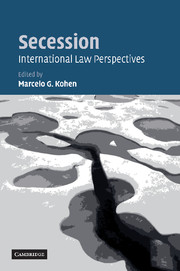Book contents
- Frontmatter
- Contents
- List of contributors
- Preface
- Table of cases
- Table of international instruments
- List of abbreviations
- Introduction
- PART I The Foundations of International Law and Their Impact on Secession
- 1 Secession and self-determination
- 2 Secession, terrorism and the right of self-determination
- 3 Secession and external intervention
- 4 The role of recognition in the law and practice of secession
- 5 The State as a ‘primary fact’: some thoughts on the principle of effectiveness
- 6 A normative ‘due process’ in the creation of States through secession
- 7 Secession and the law of State succession
- 8 Are there gaps in the international law of secession?
- PART II International and Domestic Practice
- 15 Conclusions
- Select bibliography
- Index
3 - Secession and external intervention
Published online by Cambridge University Press: 23 July 2009
- Frontmatter
- Contents
- List of contributors
- Preface
- Table of cases
- Table of international instruments
- List of abbreviations
- Introduction
- PART I The Foundations of International Law and Their Impact on Secession
- 1 Secession and self-determination
- 2 Secession, terrorism and the right of self-determination
- 3 Secession and external intervention
- 4 The role of recognition in the law and practice of secession
- 5 The State as a ‘primary fact’: some thoughts on the principle of effectiveness
- 6 A normative ‘due process’ in the creation of States through secession
- 7 Secession and the law of State succession
- 8 Are there gaps in the international law of secession?
- PART II International and Domestic Practice
- 15 Conclusions
- Select bibliography
- Index
Summary
Introduction
Secession attempts sometimes provoke external interventions. Such interventions can take various forms. They can take place by armed force, by economic coercion, or by political means, such as by means of recognition. Interventions can also originate from different actors. They can be undertaken by the United Nations, by another international organization, by a State or a group of States, or by Non-State actors. This article does not cover all possible forms of external intervention within secession processes, rather it concentrates on describing some general rules of international law that are applicable in such situations and on providing a few pertinent examples from international practice. The focus will be on the role of the United Nations (section II) and on armed intervention by third States, both at the invitation of the government concerned and without (section III).
Secession, as a legal term, means the – not necessarily forceful – breaking away of an integral part of the territory of a State and its subsequent establishment as a new State. This chapter, however, only deals with the rules that apply to a narrower concept of secession. Thus, we are not concerned with conflicts about internationally disputed territories, e.g. the cases of the Baltic States, Kashmir, Palestine, East-Timor, or the divided States such as China, Germany, Korea, Yemen. Cases of domestic conflict which merely contain a remote possibility that they will turn into a serious secession attempt such as the Basque country, Corsica and Scotland are also beyond the scope of the present work.
Information
- Type
- Chapter
- Information
- SecessionInternational Law Perspectives, pp. 65 - 93Publisher: Cambridge University PressPrint publication year: 2006
Accessibility standard: Unknown
Why this information is here
This section outlines the accessibility features of this content - including support for screen readers, full keyboard navigation and high-contrast display options. This may not be relevant for you.Accessibility Information
- 1
- Cited by
